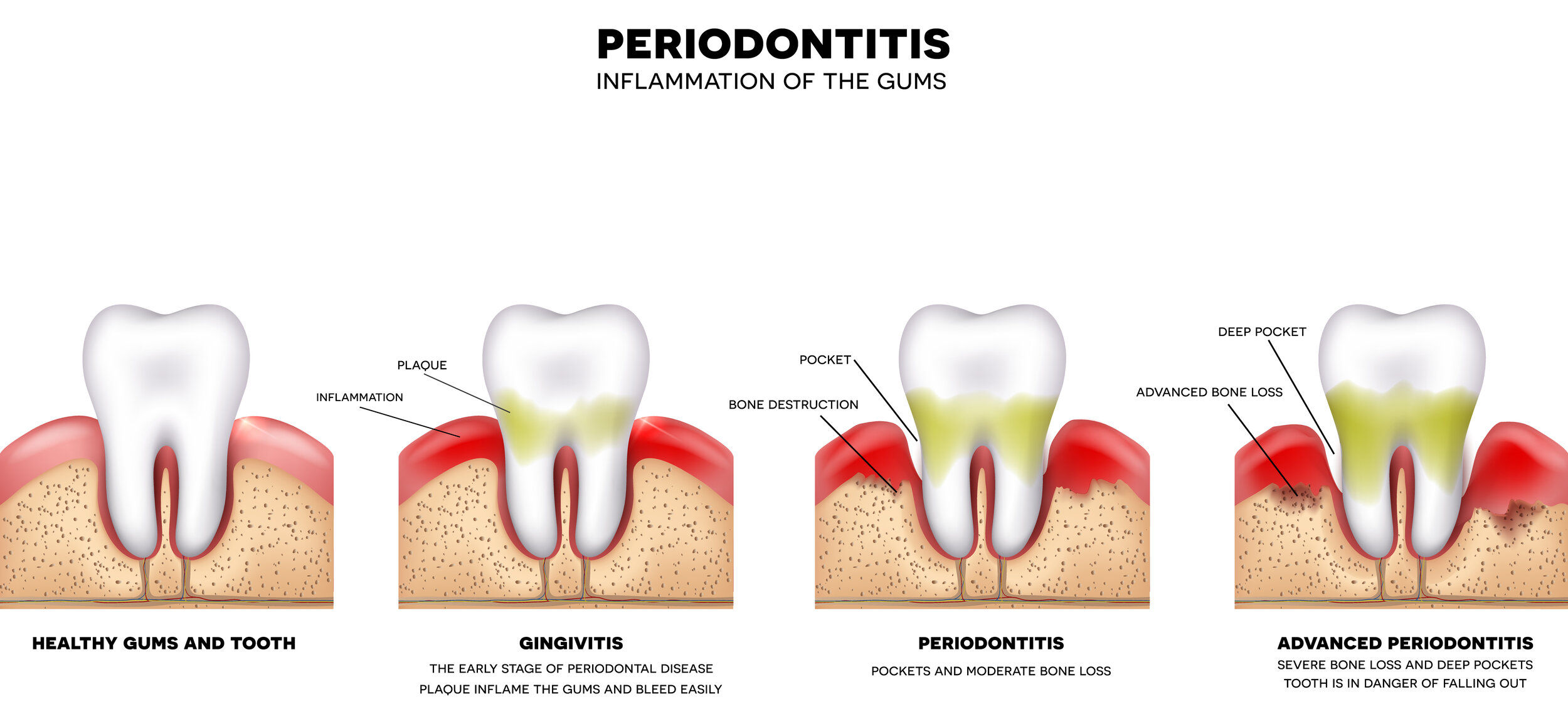
Non-Surgical Periodontal Therapy
Periodontal or Gum Disease, is an infection of the supporting tissues and bone that hold the teeth in place.
Adults over 35 lose more teeth to gum diseases (periodontal diseases) than from cavities. Three out of four adults are affected at some time in their life. The best way to prevent cavities and periodontal disease is by good tooth brushing and flossing techniques, performed daily.
Periodontal disease and decay are both caused by bacterial plaque. Plaque is a colorless film, which sticks to your teeth at the gum line. Plaque constantly forms on your teeth. By thorough daily brushing and flossing you can remove these germs and help prevent periodontal disease.
Gum disease is a progressive condition, once diagnosed and left untreated, the disease develops into series of stages. The severity of gum disease can vary depending on how far the disease has progressed. The more advanced stage to a chronic condition will require more invasive procedure or surgery to keep the disease under control.
Gingivitis — This is the early stage of gum disease, when the gums become red and swollen, and bleed easily. At this stage, this disease is treatable with good dental care from your Hygienist and can usually be eliminated. Gingivitis is NOT permanent but ignoring it could become a problem into Periodontitis.
Periodontitis — If left untreated, gingivitis will advance into periodontitis and the gums and bone that support the teeth will become seriously and irreversibly damaged. Gums infected with periodontitis can cause teeth to become loose because of ‘bone loss’ and tooth may fall out or will need extracted since your gums are not healthy enough to support your teeth.
Periodontitis can NOT be reversed, like any disease, it can only be controlled by proper dental care by methods of scaling and root planning either by hand scaling or Laser treatment.
Plaque is the primary cause of gum disease. If plaque is not removed properly by brushing and flossing, it hardens into a rough, porous substance called calculus (also known as tartar). Plaque irritates the gums, causing them to become red, tender, and swollen.
Calculus cannot be removed by brushing and flossing alone. A dentist, Periodontist or Hygienist must remove it manually to STOP the disease process. Tissues that attach the gums to the teeth are destroyed by plaque and its byproducts. The gums ‘Pull Away” from the teeth and pockets begin to form between the teeth and gums. Plaque and calculus continue to fill these pockets until eventually, the jawbone supporting the teeth is destroyed.
Treatment:
Typical treatment for periodontal disease is scaling and root planning (SRP). This is a nonsurgical method that includes cleaning the surfaces of teeth and their roots, which may be exposed due to gum recession. If periodontitis is in early or moderate but not yet advanced, treatment may involve less invasive procedures, like:
Laser Sonic Treatment for Periodontal Scaling and Root Planing also known as “A deep cleaning”, It is performed to stop periodontal disease from advancing. It is a procedure used to treat early-stages of Periodontal Disease. Scaling is performed above and below the gum line to remove plaque and tartar. Root planing gets rid of rough spots on the tooth where germs gather and helps remove bacteria that contribute to gum disease.
Our dental hygienist use Laser Treatment which is a tissue-preserving use of ultrasonic instrumentation. A laser can access an infected pocket to kill the infected tissue and bacteria. Once the infected tissue is removed and the root is exposed, the calculus is removed with an ultrasonic root cleaner instead of scraping with hand tools. Lastly, laser energy is used to warm the stem cell that contains blood in the pocket, which creates a seal of tissues against the tooth root.
Laser treatment ensures that no tissue is subtracted, or gum tissue is reduced to a lower level on purpose. It also stimulates stem cells in the tissues to form new connective tissues, bone, and collagen. The body’s healing process then regenerates the lost ligaments and bone around the tooth.
Benefits of Laser Gum Disease treatment:
Less bleeding, Pain and Swelling - The benefit of removing the bacteria but also killing them. This helps reduce bleeding and swelling of gums because periodontal laser therapy is less invasive
Recovery and Healing times are shorter - little trauma to the gum, tooth, and surrounding areas, helps heal faster.
Minimally invasive less invasive and eliminate the need for drills. This reduces the pressure that patients feel. The overall result is less pain and discomfort for patients.
Preserves healthy part of the teeth - Patients with severe bacterial infections, preserving any healthy teeth will help ensure stronger outcomes in the long run.
Minimizes the risk of bacterial infection – No multiple tools are required in procedure; laser helps with sterilizing the area you work on which helps lower the bacterial infections
Maintenance is crucial as it prevents periodontal disease from spreading. Bacteria produced by plaque may settle on the gum tissue resulting in gingivitis and periodontal disease. Periodontal maintenance is a cleaning procedure performed to thoroughly clean “above and below” the gumline of your teeth.
Maintenance prevents and halt the progression of periodontal disease. Frequent cleaning is often associated with Perio Maintenance because the bacteria activate the disease every 3-4 months. Therefore, before the detrimental bacteria invade, it should be removed from the teeth where bacteria likes to habit.
